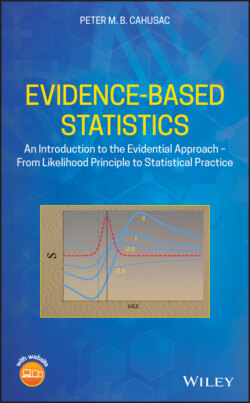Читать книгу Evidence-Based Statistics - Peter M. B. Cahusac - Страница 24
1.5 Summary of the Evidential Approach
Оглавление1 Choose a parameter value for primary hypothesis H1. Either a value corresponding to practical importance, of minimum importance, or the expected value. Else use a medium effect size, e.g. d = ±0.5. Alternatively, use the MLE.
2 Choose a secondary hypothesis H2 to compare with H1. Often this is the null hypothesis H0.
3 Calculate S12, S10 for H0, or SM for MLE.
4 Assess the relative evidence for the two hypotheses on the graded scale from −∞ to +∞.
5 Always use likelihood intervals, typically for S-2 and S-3. Likelihood intervals are more flexible and may be more informative than examining S for particular hypotheses.
6 If possible and convenient, plot the likelihood function.
Figure 1.3 gives a flow diagram showing the sequence used to calculate and assess the evidence from a data sample.
Figure 1.3 A flow diagram illustrating the general procedure of calculating and assessing evidence. At the top, we start with defining hypotheses of interest. The primary hypothesis H1 is that specified by an effect size or the sample statistic (maximum likelihood estimate (MLE)). The secondary hypothesis H2 specifies another value of interest, often this is the null hypothesis. The support S is calculated from the logarithm of the LR for H1 versus H2. If the MLE is used then the maximum LR is calculated, which becomes SM on taking logs. The value of S indicates the strength of evidence for one of the hypotheses against the other. If the value is negative then this represents evidence in favour of H2. If the value is positive then this represents evidence in favour of the primary hypothesis H1. The magnitude of the negative or positive support values indicates the relative strength of the evidence, from ±1 meaning weak, ±2 moderate, ±3 strong, and ≥±4 extremely strong. An LR of 1 represents an S of 0, which is no evidence in favour of either hypothesis. The likelihood function should be calculated wherever possible and likelihood interval provided when presenting results. Thanks to Alfaisal student, Muhammad Affan Elahi, for the suggestion to use flow charts here and for Figure 2.12.
